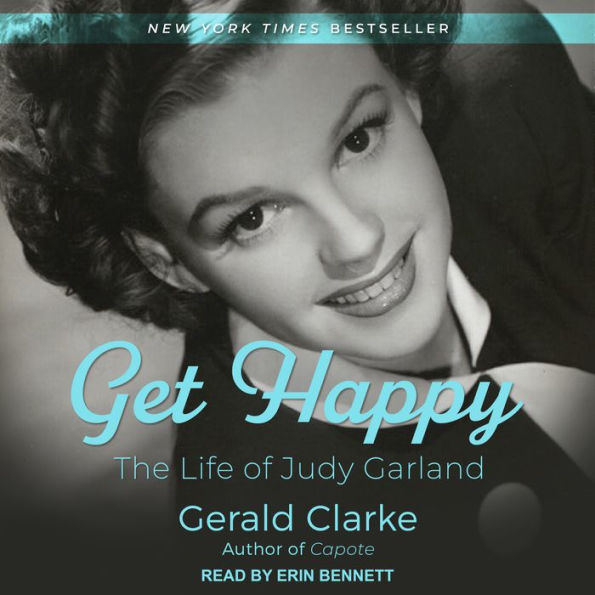Troubles That Don't Melt Like Lemon Drops
Judy Garland occupies a unique place in our hearts as the heroine who longed only for home in "The Wizard of Oz." The pink-cheeked Dorothy with the sweet and husky voice wanted only a place where she could find happiness, a place to let go of her cares. Gerald Clarke's Get Happy: The Life of Judy Garland follows Garland's sad lifelong attempts to do just that: to get happy.
From Clarke's research, it seems clear that Judy Garland's lifelong unhappiness was rooted in her childhood. Born in 1922 in Grand Rapids, Minnesota, she was the youngest of Frank and Ethel Gumm's three daughters. As a theater owner, Frank Gumm could offer a venue for displaying his daughters' talents; as a relentlessly driven, frustrated stage mother, Ethel devoted herself to developing them. Baby Gumm, as Judy was known, made her singing debut at her father's theater the age of two, and was immediately acknowledged as the star of the sister act. While Baby loved to sing and enjoyed the approval of the crowd, the grueling life of touring was hard on her—exhausting enough that her mother introduced her to uppers and downers before she was ten.
It became even harder when her family moved to California. While Baby had always been sure of her father's love, her mother's interest in her seemed entirely businesslike, and with Hollywood in her sights, Ethel pushed her even harder. By age 13, Baby was called Judy and sang with the strong voice of a woman. However, her body was still that of a pudgy adolescent, and, while there were plenty of roles for teenage beauties, it was hard for a short, chubby girl to find work in the movies. To control her weight, she began to rely on pills even more. For the rest of her life, Judy would fight her drug addiction.
When she'd finally won a contract at MGM in 1935, she (and her mother) thought her future was secure. However, she did not begin working steadily until "Broadway Melody of 1938." By her first Andy Hardy film (1938's "Love Finds Andy Hardy"), Clark writes, "MGM established the persona that [was to] remain with Judy for the rest of her screen career." Her standard character was wholesome, friendly, a good confidante—not the sex symbol she longed to be. But not even the little girl next door was allowed to be plump, so the studio took an aggressive role in slimming her down. As relentless a parent as Ethel had been, Louis B. Mayer was worse.
"The Wizard of Oz" (1939) confirmed Judy as a major star for MGM. Her wistful rendition of "Somewhere Over the Rainbow" struck a chord in her viewers at the end of the gray Depression years. It's an appropriate signature song for Judy, who would always chase the happiness that always seemed just around the corner. Throughout the films that followed, she developed a reputation for being difficult: for arriving late, for bedeviling her directors at all hours, for showing up under the influence of drugs, unable to perform. MGM opposed her attempts to seek help and actively tried to keep her out of therapy. "Meet Me in St. Louis" (1944) was a typically difficult shoot, with Judy's lateness and illness compromising the budget and schedule. As the victim of several nervous breakdowns, Judy simply became an unreliable performer.
She hung on with MGM through 1950, at which point she could no longer live up to MGM's demanding standards. Not even her habitual appetite for men had been able to lift her depression—by then she'd had three husbands, including director Vincente Minnelli (who fathered Judy's first child, Liza). In 1951, however, she reinvented herself as a concert performer, breaking all records at Broadway's Palace Theater. And her film career was not yet over; "A Star Is Born" (1954) would become known as her finest work as an actress.
Although she was working, she remained notoriously unreliable, and although she was making money, she found herself destitute. By giving her various husbands—five in all—unlimited and unquestioned access to her money and letting them manage her career, she was sometimes hard-pressed even to feed her children. For every smash opening, there was also a widely reported failure. And every time she stumbled into depression, drugs, and mediocre performances, it was that much more difficult for her to rise again.
Sick, exhausted, and addicted, Judy Garland died in 1969 of an apparent barbiturate overdose; although she had attempted suicide before, doctors concluded that her death was accidental. She never did find the happiness she longed for in "Somewhere Over the Rainbow." She never did, as Clarke regretfully concludes, "Get Happy." His chronicle of her sad life is sensitive and kind but also carefully reported and honest. He seems to wish, as many of us do, that Garland had somehow finally managed to find the place "where troubles melt like lemon drops."
—Julie Robichaux
Julie Robichaux is a freelance writer. She lives in Manhattan.



